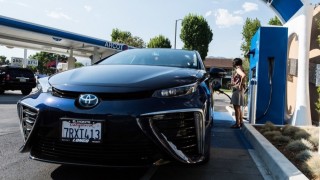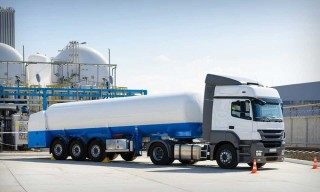Loading
Search
▼ Japan Bets On Hydrogen To Lift Its Ambitious Carbon-Neutral Plans
- Category:Other
NAMIE, Japan — Japan has ambitious plans to be entirely carbon-neutral by 2050. Trouble is: It has no clear vision of how to get there.
Japan’s nuclear industry was gutted by the 2011 tsunami in Fukushima and may never fully recover given widespread public concern over safety.
The mountainous and densely populated Japanese archipelago has limited room for large solar farms. Its narrow continental shelf poses complications for offshore wind turbines.
The government hopes hydrogen can be part of the solution, and Prime Minister Yoshihide Suga will be trying to position the country as a laboratory for an important new source of clean energy when he meets President Biden in Washington on Friday.
Toyota unveiled the world’s first mass-produced hydrogen fuel cell car in 2014 and launched its second-generation Mirai (Japanese for “future”) last year.
The government subsidizes 135 hydrogen refueling stations around the country, the largest number in the world.
Japan will further trumpet its plans to build a “hydrogen society” at the Summer Olympics, where the gas will fuel the flame in the Olympic cauldron and help power the Olympic Village. Hundreds of hydrogen fuel-cell vehicles will ferry people around during the Games.
Japan’s hydrogen plans begin, ironically, at Australia’s huge lignite coal mines and a coal-fired power station in Victoria state’s Latrobe Valley.
The idea is to use the power from brown coal, considered so dirty that even Australia’s coal-heavy energy grid is gradually moving away from it, to electrolyze water into its components: hydrogen and oxygen.
The hydrogen will then be liquefied by cooling it to minus-423 degrees and transported on specially built supertankers to a new unloading and storage terminal in the Port of Kobe.
From there it can be used to fuel power plants, transport and industry in Japan.
Kawasaki Heavy Industries, a Japanese multinational company whose products include motorbikes and aircraft engines, is calling it the “Hydrogen Road” — positioning itself as the only global company able to form an entire hydrogen supply chain, from production to transportation, storage and utilization.
“Hydrogen has a unique position and could be the next game-changer in the energy system,” said Motohiko Nishimura, vice executive officer in the company’s Hydrogen Project Development Center.
The International Energy Agency agrees. The Paris-based group said clean hydrogen has “unprecedented political and business momentum” with the potential to power anything from homes and factories to ships and planes.
“Now is the time,” it said in a 2019 report, “to scale up technologies and bring down costs.”
The problem, of course, is that burning coal to produce what is known as “gray” hydrogen doesn’t solve anything when it comes to limiting carbon output.
To produce carbon-neutral “blue” hydrogen, the carbon dioxide given off needs to be captured and stored. Kawasaki hopes eventually to do that, injecting carbon dioxide into an aquifer 2,500 meters (8,000 feet) under the sea off the Australian coast.
The world’s first liquefied hydrogen carrier, Suiso Frontier, is scheduled to make its maiden voyage to collect 1,250 cubic meters (330,000 gallons) of hydrogen in Australia this year, while the company plans to build much larger commercial tankers capable of carrying 40,000 cubic meters (10.6 million gallons) each.
Environmentalists, such as Mika Ohbayashi of the Renewable Energy Institute (REI), have decidedly mixed feelings.
Hydrogen, she said, has a place in a decarbonized Japan, but she’s unhappy with the idea of burning fossil fuels to produce it.
Critics say carbon capture and storage technology is impractical, uneconomical and potentially risky because stored carbon dioxide could leak back into the atmosphere. Projects like this one, Ohbayashi argues, are too reliant on Japan’s traditional and politically influential industrial giants — instead of the renewable energy innovators of its future.
More attractive to environmentalists is the idea using of renewable energy sources to produce what is known as “green” hydrogen.
Here, too, Japan is trying to establish itself as a leader.
In Namie, just six miles north of the wrecked Fukushima Daiichi nuclear power plant, Japan’s New Energy and Industrial Technology Development Organization (NEDO) has constructed the world’s largest “green” hydrogen plant on a site that once was intended to be home to a nuclear power plant.
Surrounding it — on more than 44 acres of fields no longer suitable for farming after being flooded with salty seawater during the 2011 tsunami — stands 68,000 photovoltaic panels powering a 20-megawatt solar farm.
Solar power not needed immediately for the grid will be used to electrolyze water to produce hydrogen — which can then be compressed to 200 bars (still as a gas rather than a liquid) and transported.
“We can use this system for grid balancing,” said Eiji Ohira, the director general of NEDO’s fuel cell and hydrogen technology office. “In the future, with many renewables on the grid, it will be very difficult to do grid balancing, because they are an unstable source of power. Batteries only work for short-term energy storage.”
The Namie plant is still a small demonstration project. The hydrogen produced helps to power a shopping mall and a sports center in the town, but not much else.
Indeed, there are strict limits on how much hydrogen can be stored within a city in Japan. (The 1937 explosion of the Hindenburg passenger airship in New Jersey stands as a powerful cautionary tale of hydrogen’s risks.)
A small explosion took place took place at a NEDO facility in Hokkaido in 2017, caused by frozen pipes, but caused only limited damage to a tank and roof.
The news was openly disclosed by the group. The nuclear accident in Fukushima taught some valuable lessons about the need for transparency, Ohira said.
Still, REI’s Ohbayashi worries that the focus on hydrogen and untested technologies is distracting Japan from investing in current renewable sources, as well as driving faster conversion to electric transportation and decentralizing the power grid with initiatives such as rooftop solar panels.
REI estimates that kind of investment could allow renewables to supply 45 percent of Japan’s total power needs by 2030, from 22 percent now.
A desire to achieve a soft landing for powerful industries involved in fossil fuels has led to some “foggy thinking” in the government, she argued.
But Andrew DeWit, a professor of comparative public policy at Rikkyo University in Tokyo, said renewables face an increasing challenge in accessing critical raw materials such as cobalt, nickel, copper and rare-earth elements. The scale of Asia’s existing coal-power infrastructure justifies more investment in carbon capture and storage technology, he added.
“There are good grounds to expect that hydrogen could play a major role in decarbonization, especially for resource-poor Japan,” DeWit said. “None of us knows the technological frontier of even a few years out, let alone three decades from now, so it seems wise to encourage a diverse portfolio of decarbonization strategies.”
- April 15, 2021
- Comment (0)
- Trackback(0)



